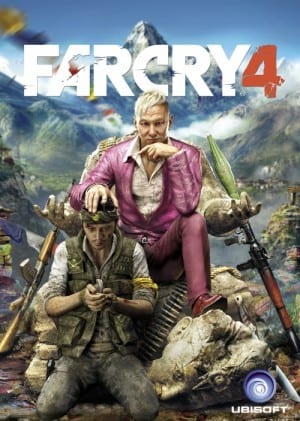
When it comes to First Person Shooters, you typically expect a lot of competitive online multiplayer where you run around, alone or with a team, trying to blast your opponent into oblivion. That’s why Far Cry 4 is so different. Sure, the competitive multiplayer component is present, but the single player campaign is so well done, so expansive, and tells such a great story that players who don’t pour the required time in to see it to completion are truly doing themselves a disservice.
Naysayers may cling to the idea that “Far Cry 4 is just Far Cry 3 with a new coat of paint.” Well, yes and no. The gameplay has remained largely the same. The map is enormous, there are hundreds of collectibles, and in addition to the main story, there are dozens of side missions to complete that can have an effect on your overall game. That’s every Far Cry.
It has worked for Ubisoft thus far, and it works again.

If you remember Vass, the antagonist from Far Cry 3, you’ll recall what made him special: he was batshit insane. Pardon the language. But Vass was a ball of insanity in human form, and people loved it. This time around you’re dealing with Pagan Min, a dictator who is struggling to deal with a country full of rebels, each trying to oust him from power. Pagan Min is a far better antagonist and is made so because of the story narrative. Where Vass was clearly the bad guy, with Pagan Min you can’t quite get a read on him.
You’re told he’s evil; you’re lead to believe he’s evil; but you never quite feel like he’s evil. He treats you well and he wants nothing more than to help you achieve your goal: to scatter your mother’s ashes somewhere in the Himalayas. It’s more believable that you’re simply fulfilling your mother’s dying wish and mistakenly get caught up in a civil war.

From the start, Pagan Min is a flamboyant presence, first appearing to the player thanks to entrance via helicopter. After viciously murdering one of his soldiers with a pen, he complains only that he got blood on his beautiful shoes. After accepting the wardrobe faux pas, Pagan Min introduces himself and begins your VIP treatment, whisking you away to his mountain fortress to dine on crab rangoons.
After your “escape” from Min’s compound, the game opens up and you’re introduced to the two leaders of the rebels. Amita is a strong, focused woman who is participating in the rebellion in order to change the culture of Kyrat, while Sabal is fighting to restore the culture they had before Pagan Min’s rise to power. The two work together only in that they’re fighting Min and his army, aside from that they have different beliefs for how Kyrat should be after Min is removed.
This is where you come in.

Throughout the story, you’re presented with different mission objectives, favoring either Sabal or Amita’s views. How you decide to complete the missions will affect which person is viewed as the “Leader” of The Golden Path, the official name of the rebels. Perhaps the most impressive thing about Far Cry 4 is this particular element to the story. Regardless of whose ideals you choose to align yourself with, you’re left second-guessing your choices. Amita wants change because the culture treats women as objects, rather than as people. Sabal is yearning for the culture lost because it’s a lifestyle that existed for thousands of years. Both make great points on why you should support them, yet neither makes you feel like they’re “the right choice.”

It’s exactly the same for Pagan Min, the man you’re trying to dethrone. And surprisingly, your choices have consequences. As you wrap up the 30+ hour campaign, you’re constantly presented with more choices, each harder than the last. As you decide who to side with, who to sacrifice, and who to show mercy to, the game itself changes to show consequences, some intended, some not.
Aside from the struggle you deal with inside the rebellion, other characters exist that add a bit of flavor to the world. Each person seems a caricature of a real person, with pros and cons brilliant exaggerated for the sake of narrative. Each of them offers a number of quests that open up new areas, unlock new items, or present a new element to gameplay that hadn’t existed prior. Some you love, some you hate, but none of them are bland.

The online multiplayer exists in two categories as well, competitive and co-op. The competitive is the weaker of the two, which faces two factions against each other in your typical “kill or be killed” gameplay. Where one faction relies heavily on weapons and armor, the other implements the “magic” that you see described throughout the story’s collectibles (of which there are hundreds). It’s an interesting take, to have one team conjuring spirit beasts as weapons, but overall it doesn’t really offer anything remarkably impressive and you won’t miss much if you opt to skip it entirely.
The co-op gameplay is different though, as it removes most story elements and allows a couple of friends the ability to move around Kyrat intent on raiding enemy fortresses and outposts. Players can earn extra XP and money for moving quickly and quietly, but most experiences descend into madness, with explosions and fires breaking out recklessly. As fun as it is to blow up a vehicle full of Pagan Min’s forces, it’s exponentially better when you’re friend is there to see it happen.

After nearly 40 hours of gameplay, most game trackers won’t be at 100% completion. Include the fact that your choices matter, meaning you have replayability for a lot of the game, and you’re looking at hundreds of potential gameplay hours, though, admittedly, most of that is for collectibles and side missions that don’t offer choices. Still, Kyrat offers fans of the Far Cry series a chance to experience a lot of what you’ve loved all over again, with a story that goes beyond what you expect and delivers many moments of jaw-dropping, second-guessing fun.
















